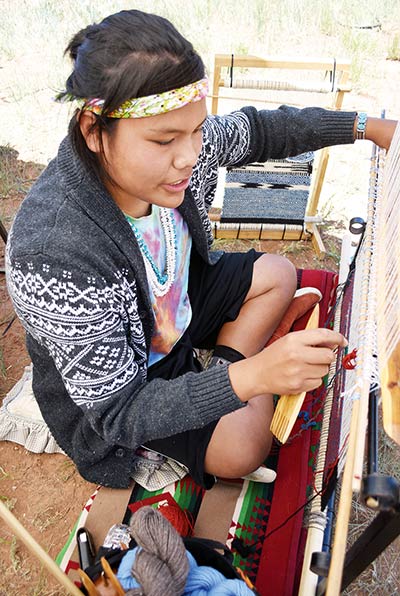
Silver shepherds

Navajo Times | Ravonelle Yazzie Fifteen-year-old Tyrrell Tapaha spends his afternoon demonstrating how to weave at the 25th annual Sheep is Life conference in Tsaile, Ariz., on Friday.
Dibé be’iina passes the batten to a new generation
TSAILE, Ariz.
Last week marked the 25th anniversary of the Sheep is Life Conference. Or, if you prefer, the 20th time the conference was held on Navajo soil. Or, if you count the first unofficial conferences at Utah State University, before the sponsoring organization, Dibé be’iina, was incorporated, this was the 31st one.
But its roots go much deeper than that.

Navajo Times | Ravonelle Yazzie
Fifteen-year-old Tyrrell Tapaha spends his afternoon demonstrating how to weave at the 25th annual Sheep is Life conference in Tsaile, Ariz., on Friday.
You could think of it as going back to 1977, when Utah State University agriculture professor Lyle McNeal established the Navajo Sheep Project after the great Annie Wauneka complained to him that the churro breed was on the verge of extinction and she needed some help to preserve it.
You could think of it as originating even before that, when McNeal was a boy listening to his grandfather, who was a part of Buffalo Bill Cody’s Wild West Show, lamenting the near-extinction of the buffalo.
That, McNeal told the audience at the conference’s closing dinner Saturday, was what set him on the path to preserving heritage breeds of livestock.
“It’s not only the churro,” he told the audience of about 80. “It’s breeds of pigs, cattle, chickens, rabbits, horses. They are the heritage of all of us, and they’re all mistreated and misvalued.”
But last week was all about the churro sheep: butchering it the proper spiritual way; cooking the meat; carding, spinning and dyeing the wool; weaving and felting.
According to conference coordinator Aretta Begay, the silver anniversary conference drew more than 600 people from all over the Four Corners and beyond – the farthest-flung participant, she said, came across the sea from Wales.
“I would say we had double the attendance of last year,” Begay said.
“It’s a lot of fun to teach people who are interested,” said Dibé be’iina President Ron Garnanez, “and that’s who shows up. Most of them are people who already have sheep, but always want to learn more.”
While Garnanez appreciates the bilagáana ranchers and hobbyists who are helping keep the churro breed alive, he was especially grateful this year for the presence of a record number of Navajo youngsters.
“They came to my butchering class,” he said. “It was so emotional to see them there, so innocent-looking.”
For the first time, the youth, most of them apprentices of the iconic Roy Kady, took a leading role in organizing the conference. They taught workshops and even served the excellent Native foods dinner cooked by Navajo/Hopi Chef Terri Ami (keynoted, of course, by tender slabs of churro lamb).
Any way you do the math, Dibé be’iina has been around for a generation. And the leaders are getting tired. Kady, who has been with the organization for 18 years, announced his resignation from the board, even as he accepted its Fiber Artist of the Year award.
“All of us are getting older,” observed board member Cindy Dvergsten. A glance around the group confirmed that; there was more grey wool than was being spun at the fiber arts classes. Dvergsten confided that she intended to use the conference’s closing event, a pancake breakfast on Sunday, to lobby the young members to seek a seat on the board.
Garnanez, himself a sprightly hexagenarian, is confident they’ll step up.
“The way I see this group, the young people and the elders just appreciate each other so much,” he said. “We never fight. And you know Navajos, we can fight.”
Garnanez attributes the group’s calm demeanor to weaving.
“Weaving is our Prozac,” he said. “It just unwinds you.”
As for the next 25 years, we’ll see what the great Shepherd in the sky has in store — there’s talk of a woolen mill in Bayfield, Colo. specifically geared to the coarse churro wool. But at least the next four years are assured.
“Last year, we signed a five-year contract with Diné College,” Begay said. “For the next four years, Sheep is Life will be the third weekend in June at Diné College. It’s been a wonderful collaboration between the Dibé be’iina board, the college administration and the college’s Land Grant Office. This brings some stability to the event we haven’t had in the past.”
Dibé be’iina is an all-volunteer organization, and it basically takes all year to plan the next conference, so if sheep are your life, don’t be baa-shful about volunteering.
Information: navajolifeways.org
To read the full article, pick up your copy of the Navajo Times at your nearest newsstand Thursday mornings!
Are you a digital subscriber? Read the most recent three weeks of stories by logging in to your online account.







 Highway 264,
Highway 264, I-40, WB @ Winslow
I-40, WB @ Winslow